Claussen Pickles are kosher dill pickles at their crunchiest, saltiest best! These homemade Claussen pickles taste like the commercial ones you find at the store, but better. And better yet, they’re ridiculously easy to make!
Whether you’re new to pickle making or a pickle veteran, you NEED to make these half sour pickles! And wonder of wonders, you don’t need to know how to can to make these super fresh, crunchy pickles! Claussen dill pickles are meant to be eaten fresh.
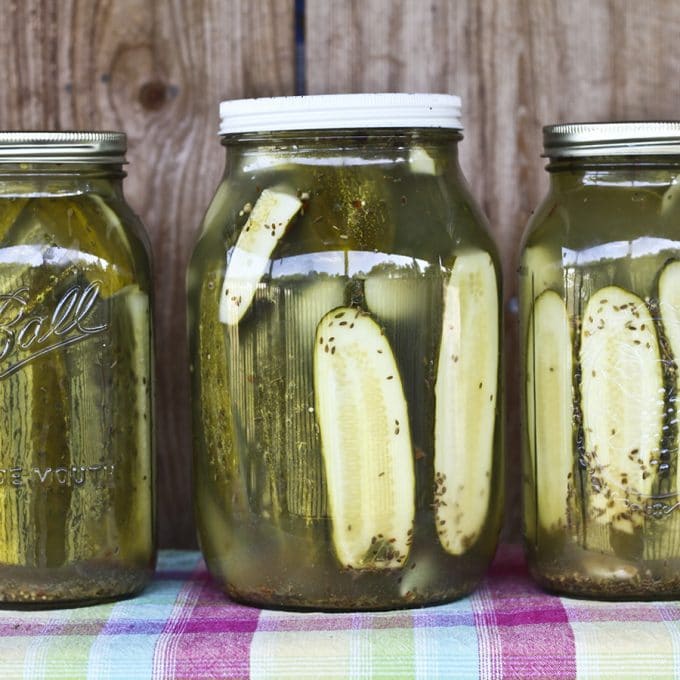
Homemade Claussen Knock-Off Pickles: Always crunchy and garlicky, this perfect homemade pickle recipe requires no special equipment, & no canning experience.
It’s common knowledge that I have a salty tooth rather than a sweet tooth. When the weather does what it has been doing lately (making us all do our best Shadrach, Meshach and Abednego impersonations) I can’t think of a single thing I find more refreshing than an icy-cold, salty, crunchy pickle.
It’s not just me, it’s my whole family: mother, sisters, brothers, cousins, aunts, grandparents, kids, husband… I married a man who loves pickles so much he eats the pickles and then drinks the juice from the jar.
I grew up eating my Grandma’s homemade dill pickles like the supply was endless and moved on to canning my own pickles as soon as I had a kitchen of my own. There’s just something about a homemade dill pickle that makes me happier than any pickled cucumber ever should.
My little sister, Jessamine, and I compare our homemade pickles from year to year the way some people compare wine vintages.
Dill Pickle Recipe
But there is one pickle that stands head-and-shoulders (were pickles to *have* heads and shoulders) above all others. I’m talking about the pickles you see here. That’s right: Homemade Claussen Dill Pickles.
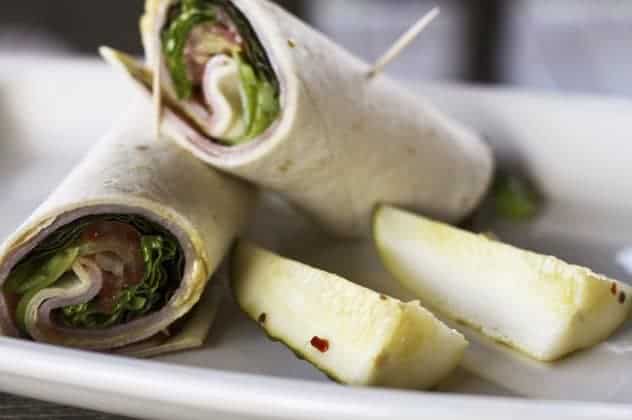
Recipe for Claussen Pickles
What do you need in order to make this recipe for Claussen Half Sour Pickles at home? Let’s get a quick list for both ingredients and equipment out of the way, shall we?
Equipment for Making Claussen Pickles at Home
- A Glass gallon jar or 4 glass quart jars or other food safe container with a tight fitting lid
- Measuring cup
- Chef’s knife or paring knife
Ingredients for Making Homemade Claussen Pickles Copycat
- Small to medium size pickling cucumbers (check your local farm stand or farmer’s market!)
- Apple Cider Vinegar (don’t fret- it doesn’t taste like apple cider and isn’t even a little sweet!) or white vinegar
- Kosher Salt
- Garlic
- Dill (either fresh or dill seed)
- Pickling spices (available here)
A quite note on your vinegar choice: I opt for apple cider vinegar because it’s a smoother vinegar than white vinegar. It does not impart any sweetness or apple taste to the pickles whatsoever.
If you can’t find it (pssst. It’s right next to white vinegar in even moderately stocked grocery stores) or don’t feel like buying it, you can most certainly substitute white vinegar. It’ll just taste a little sharper. (And technically store bought Claussen pickles have white vinegar, so you do you!)
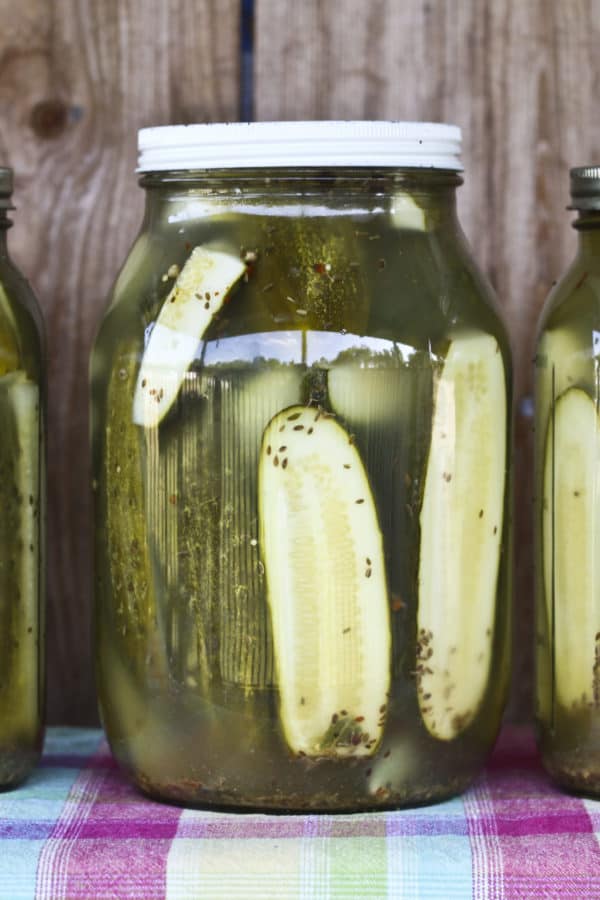
And ya’ll. These homemade half sour pickles are so easy to make it’s almost criminal.
The hardest part is the 2 to 4 day wait for them to be done. Truth be told, though, I’ve snacked on them the day after I made them and been a very happy camper.
Claussen Pickle Recipe
These are homemade refrigerated deli pickles, also known as Lithuanian half-sours, also known (in the commercial equivalent) as Claussen dill kosher pickles, also known as the best pickles ever known to mankind.
Here’s the thing. While I do love my other homemade pickles dearly (otherwise why would I continue canning ninety-something quarts year after year after year), these are by far my all-time favourites.
CRUNCH. That’s what you hear when you bite these. There is no flop, no squish, no soft pickles. These things almost bite back.
This also happens to be the perfect dill pickle recipe for beginning pickle makers. If you’re not into canning, these refrigerator pickles are a godsend. Even if you ARE canning obsessed, like yours truly, this Claussen pickle recipe should be in your pickle repertoire too.
Please note that this Claussen pickle recipe is not suitable for canning. The brine is fermented and not very acidic, which means it has far too high a PH to can safely. If you’re looking for a great canned dill pickle recipe, try this home canned garlic dill pickle recipe.
Refrigerator Pickles
Here’s where we get into the best part of this pickle recipe (aside from the crunch and flavor). You don’t have to cook anything to make these pickles; not one single thing. The brine is stirred together, the cucumbers are rinsed, trimmed and stuffed into a jar with garlic cloves and spices.
These half sour pickles are NOT CANNED. They are simply put into jars. Amen!
When it’s summer time and the idea of turning on the stove makes me want to crawl into an (air conditioned) hole, these pickles are a welcome treat. Not only is that cold crunchy refrigerator pickle waiting to cool me off at the end of the prep time, but I don’t have to heat up my kitchen by even one single degree to get there.
Remember that pickling isn’t just for cucumbers, either! Try out our Pickled Brussels Sprouts, Quick Pickled Red Onions, and famous Candied Jalapenos!
How to Make Pickles FAQ
Please, please, please give these a go even if you have never made a pickle before. There is nothing scary or intimidating here. Wash, slice, stuff, stir, pour, sit, wait.
- Trim 1/8-inch from the blossom end of each cucumber and slice them in half lengthwise or into quarters. The size you choose depends on how large your cucumbers are and how big you want the pickles to be when they’re done. This helps minimize the chances of soft pickles.
- In a gallon jar (or large, wide-mouth, food-safe container) layer the dill heads or seed, pickling spice or mustard seed, and garlic cloves and sliced cucumbers. If you’re dividing the cucumbers up between smaller containers, just divide the garlic and spices evenly between the containers, too.
- Stir your brine together in a separate container. You WILL have more brine than you have space for in the jars, but that’s why you pack the spices in the jars. Just store extra brine in a jar in the refrigerator and use it to top off your pickles if the brine starts evaporating.
- Pour the brine over the cucumbers, taking care to make sure all of them are fully submerged. If needed, place a plate or mug or other ziploc bagged can of beans on the cucumbers to weigh them down and keep them under the brine!
- Cover the jars lightly not tightly and leave out of direct sunlight on the counter for two to four days or until the pickles are picklicious.
- If your kitchen is pretty hot or humid, you can stash them directly in the refrigerator. They’ll just take a couple of days longer to get fabulous. Your patience will be rewarded.
On the plus side, the wait is only two to four days which is significantly less than the six week wait of the canned pickles. Besides, as I said, there is the crunch factor
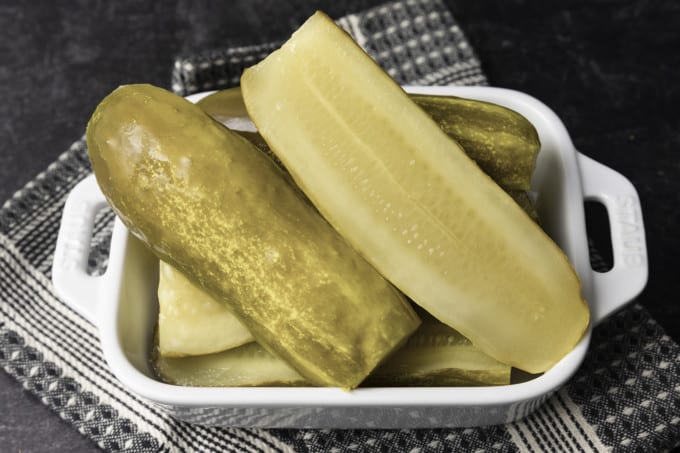
Troubleshooting Your Homemade Claussen Pickles
These pickles are easy peasy to make, but there still may be a couple of things that pop up from time to time that make you go “Hmmm…” In no particular order, here are some of the most commonly asked questions about them and some answers!
- Why is my pickle brine cloudy? Okay, I lied. This is the most common question and that’s because the brine becomes cloudy naturally as a consequence of fermentation (which is what’s happening here.) No worries.
It’s all natural. This half sour pickle recipe (more on this to come) is a fermented pickle recipe and that just happens.
Another possible cause of intense cloudiness or discolouration in your brine is using table salt. The iodine in table salt can also give off flavours to your pickles, so it’s best to stick with kosher salt or pickling salt for these bad boys! - Is the scum, foam, or film on top of my pickle brine dangerous? It’s that pesky (and delicious) fermentation again! This is another thing you don’t have to worry about.
Just scrape it off with a spoon, discard, and top off with a little of that extra brine you whipped up. (See the recipe card for details.) But do remove the scum or it could cause your pickles to go bad. - My pickles went soft! How do I prevent this? This particular tragedy could have two causes.
First, you may have failed to remove enough of the blossom end of the cucumber. There is a naturally occurring enzyme in the blossom end of cucumbers that causes pickles to break down and become soft if it is not removed. Next time, just slice more off.
Second, you may have started with less than spectacularly fresh cucumbers. An older cucumber has had longer for the aforementioned enzyme to kick in, and it has already started its work.
The best solution for this issue is to use cucumbers that have either been picked fresh that day or have been refrigerated steadily since very shortly after being picked a couple of days previously. - Why did my pickles go bad? See that second reason in the “why did my pickles go soft” bullet point? That’s one culprit.
Other potential causes of spoiled pickles are using unwashed cucumbers or fresh dill, old or decayed garlic, bad spices, lower-than-5%-acidity-vinegar, failing to remove the scum from the brine or to keep the pickles submerged in the brine, or storing your pickles in warmer conditions. When in doubt, stash them in the refrigerator! - Why is there mold on my pickles? First, you have my condolences. Second, it’s because your pickles didn’t stay submerged in the brine. That brine has enough salt and acid to prevent mold growth if the cucumbers stay under the surface.
If you’re having trouble finding something that fits in the jar to keep this from happening, try popping a can or two of tomato paste or canned beans in a zipper top bag and gently inserting that into the jar. It should weigh it down enough to do the job. - Should I worry about the white sediment in my jar? This is another one in the “don’t sweat it” category. There are two potential reasons and both are completely harmless.
It’s either a natural consequence of the fermentation or anti-caking agents in the salt. Neither harms the pickles or effects the flavour, so don’t worry! - Why is my garlic blue/green/purple? As long you inspect the garlic before it goes into your jars and it is fresh as a daisy, you have nothing to worry about. It could be the type of salt you used or it could be the variety of garlic. Some types of garlic have a natural propensity to change pretty colours in vinegar.
It also may mean that your pickles were exposed to light. When garlic is exposed to light, it starts producing chlorophyll which is green. It also may indicate that your garlic is more mature.
In that case it is caused by sulfur compounds that naturally occur in more mature garlic reacting with minute traces of copper in the vinegar., but as long as there are no other signs of spoilage (soft or squishy texture, funky smell, discoloured spots), you’re good to go.
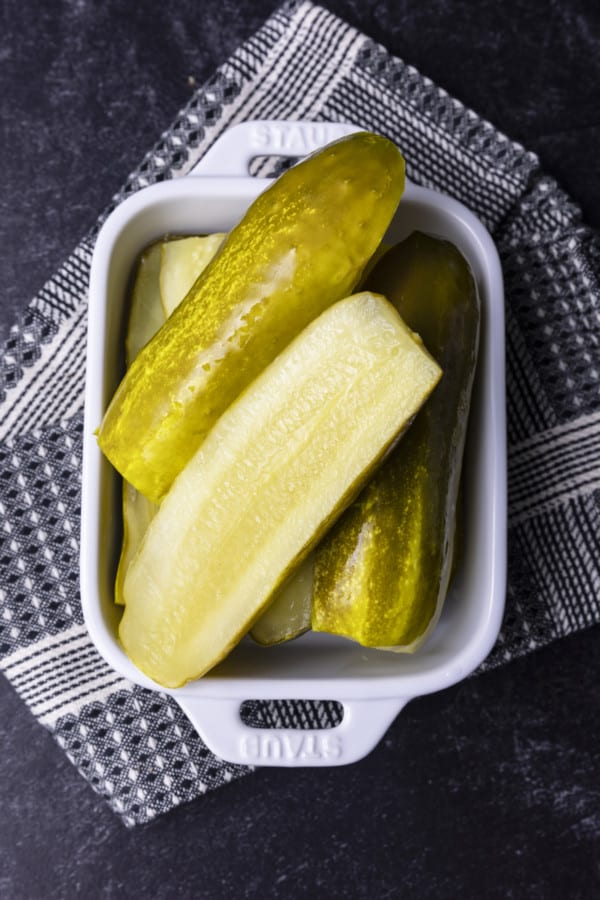
IMPORTANT NOTE: Because there is so much diversity in temperature, humidity, age of cucumbers, etc… involved in this recipe, please check your half sour pickles starting at 24 hours for doneness. If the pickles smell/taste pickley, move them to the refrigerator. Do not keep them on the counter longer than 4 days.
ANOTHER IMPORTANT NOTE: These pickles are not suitable for canning. They’re simply not acidic enough to can safely, and that is in addition to the fact that you’d ruin that perfectly crisp texture by introducing heat to the party.
What can I serve with these Homemade Claussen Knock-Off Pickles?
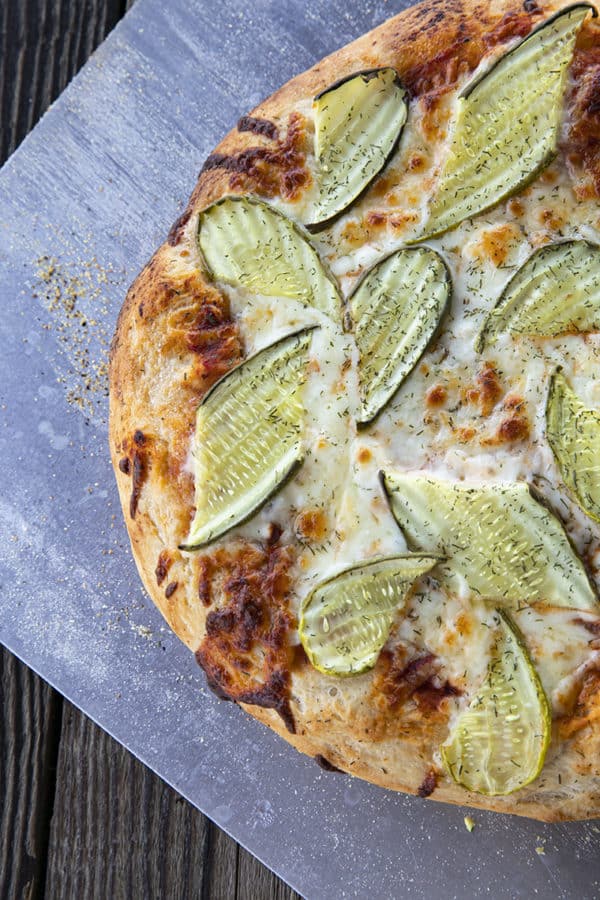
Start out by trying your half sour pickles in this Pickle de Gallo, Dill Pickle Dip, Dill Pickle Egg Salad, or Bagel Burgers with Dill Pickle Cream Cheese.
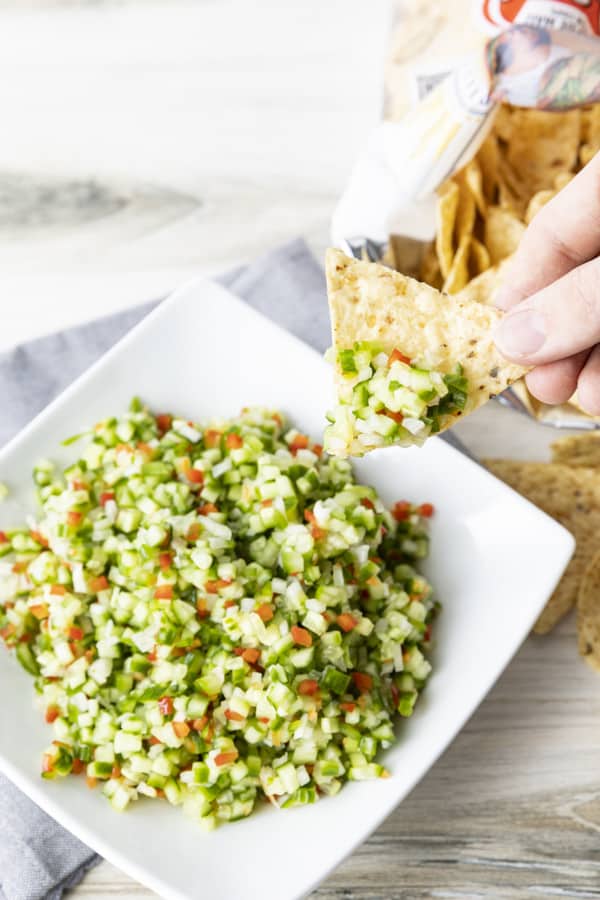
Even better, serve them on our Cheeseburger Salad or Pickle Pizza.
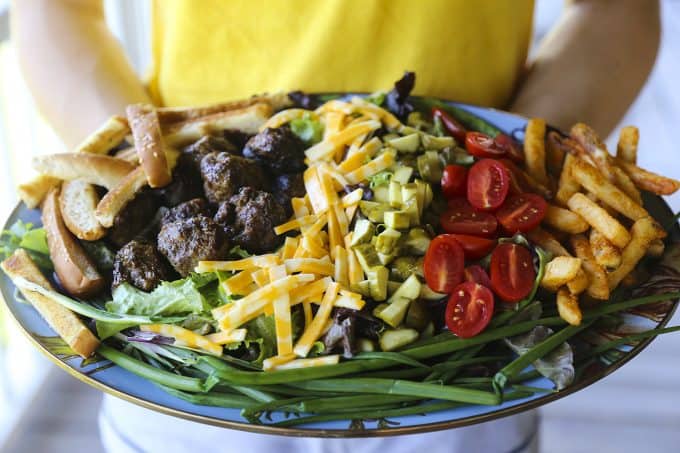
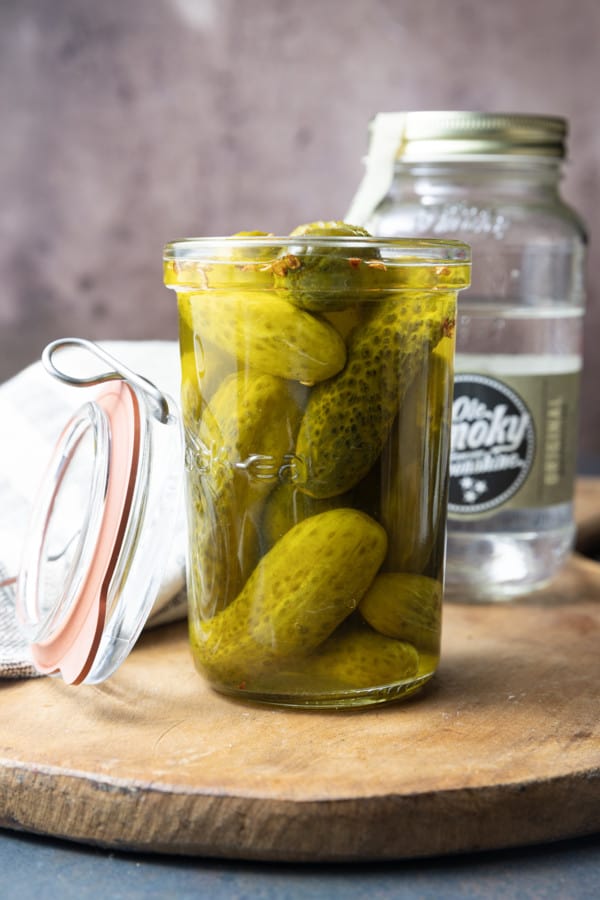
You can even take extra pickles (like that’s a thing!) and make these divine Moonshine Pickles. You’ve never had a better Bloody Mary than one made with homemade Moonshine Pickles!
Half Sour Pickle Recipe
What makes Claussen PIckles different from canned pickles? Claussen pickles, whether homemade or store bought, are a half sour pickle recipe.
That means they’re fermented instead of heat processed. That’s what gives them such great texture.
This half sour pickle recipe yields pickles that are crunchy to the point of making noise when you bite them, cold, and seriously garlicky. Canned, shelf-stable pickles can be chilled, maintain some crunch, and be as garlicky as you want them to be, but they are never, ever going to be the same thing because of science.
When you heat process a jar of pickles you are, in actuality, cooking it and a cooked pickle just plain can’t be as crunchy as an un-cooked half sour pickle recipe.
These homemade pickles keep well in the fridge for about six months, as long as they remain submerged in the brine. In our house, they never last that long because, as the saying goes, “A pickle a day keeps sad times away.”
They say that right? Someone must. If not, I’m going to start. It’s true, after all.
Claussen Pickles
Wash cucumbers but do not scrub them.
Trim 1/8-inch to 1/4-inch from the blossom end of each cucumber and slice in half lengthwise or into quarters, depending on how large your cucumbers are and how big you want them to be when they’re done.
Layer the dill heads or seed, garlic cloves, pickling spices and sliced cucumbers in a gallon jar (or large, wide-mouth, food-safe container). You can evenly divide the dill, garlic cloves, pickling spices, and cucumbers between several smaller jars if needed.
In a separate pitcher or bowl, stir together the remaining ingredients until the salt is dissolved.
Pour the brine over the cucumbers, taking care to make sure all of them are fully submerged. If needed, place a plate or mug or other non-reactive heavy item on the cucumbers to weigh them down and keep them under the brine!
Cover lightly with a lid just perched on top or secure a piece of cheesecloth over the jar with a rubber band to keep fruit flies away. Store any extra brine in a covered jar or pitcher in the refrigerator and use it to top off the brine if it starts to evaporate and expose the pickles to the air.
Leave out of direct sunlight on the counter for at least 24 hours, but up to 4 days, or until the cucumbers taste like pickles throughout.
Fix your lid onto your jar or container and chill thoroughly. These can be stored in the refrigerator for up to six months provided you keep them covered with brine.
NOTE: If at any point in the proceedings “fuzz” or “foam” develops on top of the brine, use a spoon to remove it. If there is “fuzz” attached to any of the cucumbers, remove the ones affected and be sure the others are still fully submerged.
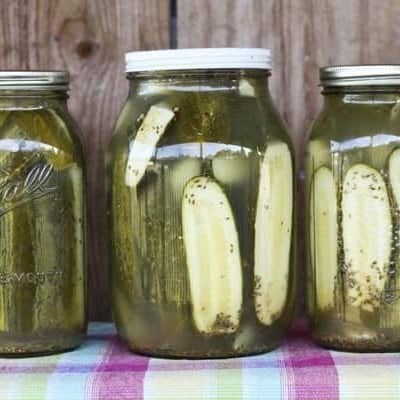
Homemade Claussen Knock-Off Pickles
Equipment
- 1 gallon jar or 4 quart jars or a large, food-safe container with a tight fitting lid
- 1 liquid measuring cup
- 1 large mixing bowl or pitcher
Ingredients
- 35 to 40 small to medium pickling cucumbers
- 1 gallon cold water
- 1 cup apple cider vinegar, preferably raw or white distilled vinegar
- 2/3 cup coarse canning or kosher salt Do NOT fine or use iodized salt!
- 4 cloves garlic or more to taste
- 4 heads fresh dill or 4 tablespoons dried dill seed not weed!
- 2 tablespoons mixed pickling spices
Instructions
- Wash cucumbers but do not scrub them.
- Trim 1/8-inch from the blossom end of each cucumber and slice in half lengthwise or into quarters, depending on how large your cucumbers are and how big you want them to be when they’re done.
- In a gallon jar (or large, wide-mouth, food-safe container) layer the dill heads or seed, garlic cloves, pickling spices and sliced cucumbers.
- In a separate pitcher or bowl, stir together the remaining ingredients until the salt is dissolved.
- Pour the brine over the cucumbers, taking care to make sure all of them are fully submerged. If needed, place a plate or mug or other non-reactive heavy item on the cucumbers to weigh them down and keep them under the brine!
- Cover lightly with a lid just perched on top or secure a piece of cheesecloth over the jar with a rubber band to keep fruit flies away.
- Leave out of direct sunlight on the counter for two to four days*, or until the cucumbers taste like pickles throughout.
- Fix your lid onto your jar or container and chill. These can be stored in the refrigerator for up to six months provided you keep them covered with brine.
- *If at any point in the proceedings “fuzz” or “foam” develops on top of the brine, use a spoon to remove it. If there is “fuzz” attached to any of the cucumbers, remove the ones affected and be sure the others are still fully submerged.
Notes
Nutrition
Nutritional information is an estimate and provided to you as a courtesy. You should calculate the nutritional information with the actual ingredients used in your recipe using your preferred nutrition calculator.
did you make this recipe?
Make sure to tag @foodiewithfam on Instagram and #hashtag it #foodiewithfamily so I can check it out!
Originally published July 22, 2011. Updated with FAQs and Troubleshooting and reposted August 2022.
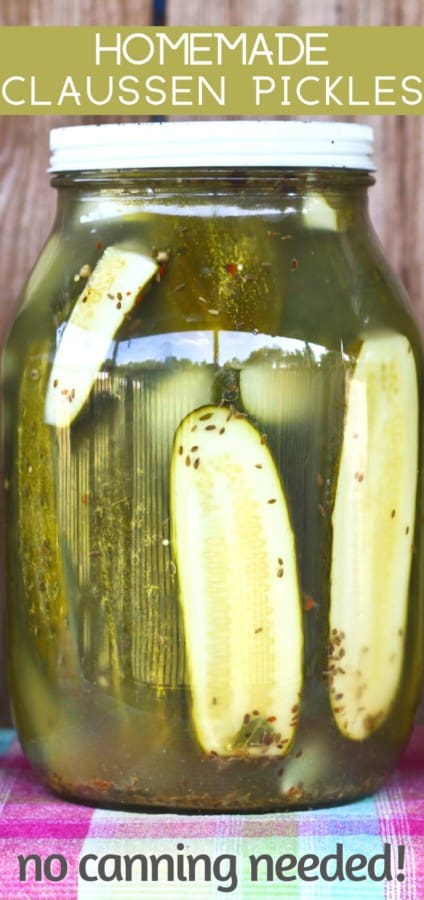
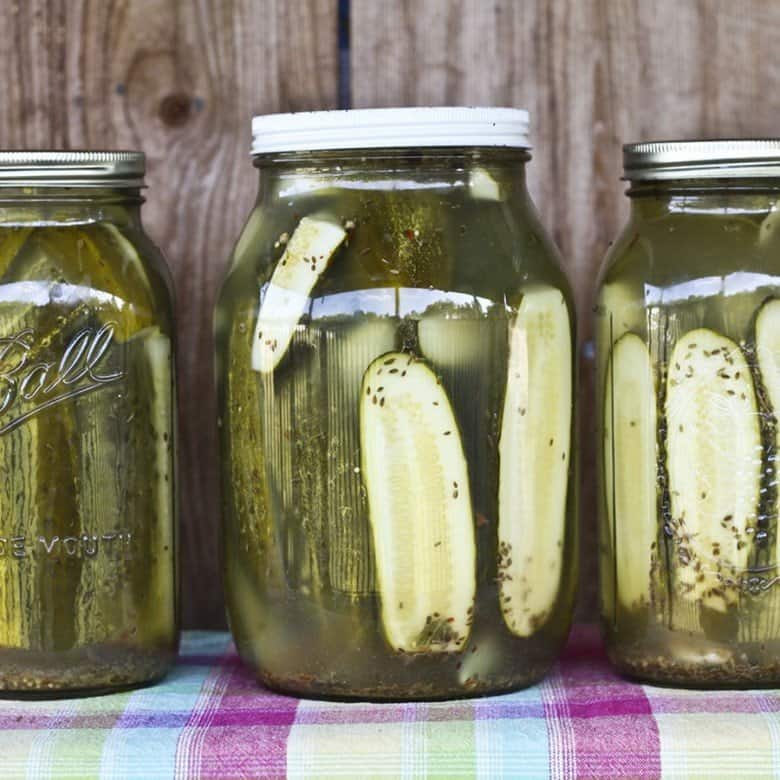
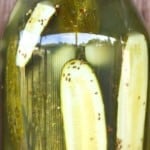



Reader's Thoughts...
Jim says
Why no measures? I truly hate wasting my time reading a bunch of stories about how much you love your pickle recipe and share the ingredients but not how much. Thanks.
Rebecca says
Jim- The measurements are all there. I’m not sure what you mean. It gives a range of cucumbers because you may not be able to fit more than 35 in the jar if they’re large. It gives exact amounts for the spices, vinegar, water… Which measurements do you feel are lacking?
Wanda Pearson says
How much kosher salt do you use
Rebecca says
Hi Wanda- If you’re using Morton’s Kosher Salt (not Diamond) the volume should be close enough to pickling salt to substitute it in equal amounts.
Pam says
Checked my pickles after 2 1/2 days and had a filmy foam and some bubbles in a few of the jars. I had just read an article on botulism so I ended up throwing those away. Have you ever heard of anyone getting botulism from pickles? I tried to download a picture but I couldn’t here.
Pan says
So I never did see a reply to my email. So I did throw away about 4 jars and my son just came over this week. Opened up one of the jars in the fridge and couldn’t stay out of them! Said these are even better than Claussens !! Had to call his older brother and let him know about the delicious pickles mom made!! So thank you for this great recipe. I know what to look for now and will be making multiple recipes next year. What kind of peppers would you recommend to add? He said that is the only thing to add.
Rebecca says
Hi Pam- Thanks so much! I’m so glad you and your son loved them! They’re kind of addictive, aren’t they? Did he want hot peppers or sweet peppers? I haven’t tried either in here so please let me know what you go with and how it works out for you! Happy Thanksgiving!
Pam says
Checked my pickles after 2 1/2 days and had a filmy foam and some bubbles in a few of the jars. I had just read an article on botulism so I ended up throwing those away. Have you ever heard of anyone getting botulism from pickles?
Tony says
They’re great! Thank you for your recipe. I added crushed red pepper from the pizza parlor into a couple of jars. Those were great too!
Rebecca says
Thanks so much for taking the time to rate the recipe and let me know you love it, Tony!
Alpha Garner says
Your husband is right. Pickle juice is used by runners who compete in marathons, because the concentrated electrolytes it keeps the muscles extremely hydrated and prevents cramping. When I was young and worked industrial construction, and old pipefitter told me about this.
Rebecca says
That’s awesome, Alpha! Thanks for taking the time to let me know my husband is right. HAHAHA. But really, I knew he was onto something when I had a glass of ice cold pickle juice on a hot day and felt like a million bucks.
David Richards says
What a great recipe for delicious pickles! I adjusted the cider vinegar and water ratios a bit to taste and added a bit more pickling spice and a small amount of red pepper flakes, again to taste, but this is an outstanding recipe. Like the author indicated in her narrative about her experiences, there is no way these pickles will last 6 months – so far, they barely last a day! Thanks for sharing!
Rebecca says
Thanks so much for taking the time to rate the recipe and let me know you love it, David! I truly appreciate it!
Stacy says
Question? I made 4 gallons of pickles, but, have you ever tried this recipe for pickled eggs? My husband wants me to use your recipe for pickled eggs well, here goes. 🤣🤷🏻♀️
Rebecca says
I would DEFINITELY use the leftover brine for pickled eggs… I wouldn’t start it with eggs, but once you’ve eaten all of the pickles from a batch, I’d plunk eggs into it. 🙂
Ashley says
Are they supposed to look foggy after a few days? Mine look foggy and there is a white layer on bottom. Are they still okay to eat? TIA
Rebecca says
They sure are!! That cloudy look to the brine is a natural by-product of fermentation. And the white layer on the bottom is fine. 🙂 Now, if the top of your jar had a layer of mold or fuzz, I’d chuck it!
Katie says
Hey, so I am confused…it seems as though the “pickling spices” are a key element here, but there is no hint as to what that actually consists of. It could be a combination of literally anything. Is there a secret way to access what these spices are? Thanks so much!
Rebecca says
Hi Katie- There’s no secret to it. 🙂 Pickling spices is a blend sold by most major spice companies and it’s found in the spice aisle at the grocery store. McCormick is a pretty commonly available brand that offers pickling spices.
Bill says
If the lids crease, the liquid is milky, filthy be bad? Also exposure to extreme heat will they be bad?
Rebecca says
If they were exposed to extreme heat I would not take a chance particularly with the other things you mentioned 🙁
Cloudy brine is not a problem but milky plus all these other issues sounds problematic.
Devin says
I followed the recipe exact,and on day 2 the jar was hazy and white mold formed on the pickles.
Rebecca says
Hi Devin- That’s crazy! Hazy is not an issue. Cloudy is normal. Mold is not. I wonder if you had some bad cucumbers!
Marcie says
Are.you sure these measurements are correct?
I triple checked the amounts of the ingredients according to the recipe and actually, I would be amazed if this brine would be strong enough to pickle anything. Hopefully it will get stronger as I sits.
Rebecca says
Yes, Marcie. I’m sure they’re correct. I’ve made these many, many times. You’re working on fermenting the cucumbers, not straight up pickling them which would take a much larger quantity of vinegar. These are going to develop flavour similar to a Claussen refrigerated pickle.
Nadine Heck says
My first try at these and the brine is cloudy. Are they spoiled?
Rebecca says
You’re fine, Nadine! No worries. Brine is sometimes cloudy as a natural by-product of fermentation. As long as they smell/taste like pickles you’re a-okay!!
The only time you need to worry is if it smells unpleasant or has mold on the pickles.
Blaine says
It’s the end of August and in another couple of month or three I’ll be pulling our first batch of Sunchokes -> Jerusalem Artichokes. We can most all of our Fall harvest as pickles and relishes because they taste so good. I prefer them to cukes, and because the vinegar converts the flatulence causing Inulin into Fructose. I’ll be trying this recipe on them, but they’ll be sitting in the fridge after they ferment for a couple of weeks for the vinegar to work on them.
The rest I leave to freeze over winter. That’s another way to convert the Inulin into Fructose. That’s when we’ll be frying, boiling, roasting, stir frying and drying them for flour and snack chips.
PS: I love Claussen’s.
Rebecca says
I have never tried pickled sunchokes!!! I’m going to need to give that a go!
Sandy says
Follow the recipe to a T and all the pickles deteriorated and we’re totally mush what did I do wrong??
Rebecca says
Well, let’s see if we can trouble shoot this for you. I’ll let you know some of the more common mistakes and you can let me know if any of these fit.
1) Using cucumbers not specifically labeled as pickling cucumbers.
2) Using cucumbers that are not same-day fresh or are over-mature.
3) Not slicing off the blossom end of the cucumber.
4) Not paying attention to the cucumbers while in the brine; waiting too long to refrigerate them.
5) Putting the jar in which the pickles are fermenting either in direct sunlight or in a room with an unsteady room temp.
6) Not measuring brine ingredients correctly.
7) Pouring hot brine in on the cucumbers instead of taking the time to properly chill the brine through.
Do any of those sound familiar? I want to help you succeed here!!!
Ron says
Can you increase salt. Mine seemed that they did not have enough.
Rebecca says
Hi Ron- You can increase the salt a bit to taste after the pickling process is done. I’d recommend making a saltier brine on the side and adding it to your pickles to taste when they’re done. Much more salt added at the beginning will slow down or stop the pickling process.
Linda Moore says
These are fantastic! I didn’t have all the spices I needed and noticed it, but no matter… they were still amazing!
Rebecca says
Thanks so much for taking the time to rate the recipe and let me know you love it, Linda! I appreciate it and am so glad you’re enjoying your pickles!
Liz Smith says
I love the recipe, but I am kind of confused by the portions. If you have a gallon jar or 2 – 1/2 gallon jars, once you put all the cumbers in them, there isn’t room for a gallon and 1 cup of liquid. SO I am concerned that my ratio of water, vinegar and salt aren’t correct. Are you supposed to have extra? And can you keep the extra in a jar to make more pickles later or does it have to be made all at once?
Rebecca says
Hi Liz- You will definitely have extra and you can keep it in a jar. In fact, you should! 🙂 I engineered this recipe to have extra brine because depending on the temperature and humidity, you may find your brine evaporating at a rate faster than your pickles are, er, pickling at room temperature. Having the extra brine handy makes it easy to top off the jar and keep your cukes submerged.
If you find yourself with extra when the process is done, you can most definitely use it to make more pickles.
Liz Smith says
Thanks for the reply!
Rebecca says
Any time!
Trish Brackebush says
Try